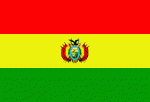
Bolivia
Quick reference
General issues: Republic 1867-Present
Country name on general issues: Bolivia
Special issues:
- Regional issues: Beni 1946
- Local issues: Santa Cruz 1911, Villa Bella 1911
Currency: 1 Boliviano =100 Centavos 1867-1963, 1 Peso Boliviano = 100 Centavos 1963-1987, 1 Boliviano = 100 Centavos 1987-Present
Population: 1 744 000 in 1900, 10 600 000 in 2014
Political history Bolivia
Colonization and independence
Bolivia is located in South America. Before colonization the population consisted of Amerindian peoples. The largest of these were the Andean peoples of the Quechuas and the Aymaras – peoples also found in the neighboring Andean nations. The Quechuas formed the Inca empire that, just prior to colonization, controlled the Andean region of Bolivia with their capital in neighboring Peru. In the eastern regions of Bolivia a range of smaller Amerindian peoples lived. The Spanish conquered the Inca empire between 1522 and 1533. Bolivia – then known as Upper Peru – would first become part of the Viceroyalty of Peru and from 1776 part of the Viceroyalty of Rio de la Plata as the Audiencia de Charcas.
As Napoleon conquered Spain, a wave of what would become independence movements swept across the Spanish possessions in the Americas. In Bolivia the first calls for independence were heard in Chuquisaca – the capital , the current Sucre – and in La Paz in 1809. The junta or government in Chuquisca demanded more self government, the junta in La Paz proclaimed independence. The calls for independence were short lived as the royalists loyal to Spain would soon overthrew the juntas. The war of independence that ensued would last until 1825 when the royalists were defeated by Antonio José de Sucre, the commander in chief of Simón Bolívar, the most outstanding of the ‘libertadores’ in South America. Independence was proclaimed as the Republic of Bolivar, which would in 1868 become the Republic of Bolivia. Bolívar became the first president of Bolivia in 1825, to be succeeded by Sucre in 1826. In 1836, Bolivia joined Peru in the Peru-Bolivian Confederation, which was short lived and dissolved after the War of the Confederation in 1839.
Politics in the 19th an 20th centuries
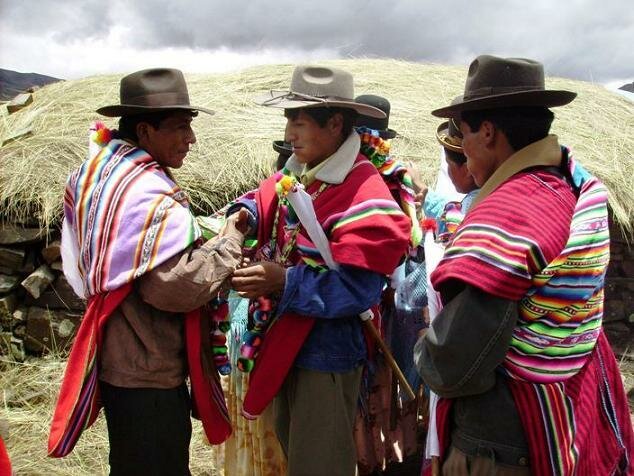
The Aymara are the second largest Amerindian population group in Bolivia. Here shown wearing a partly traditional outfit.
From independence to well into the 19th century the political landscape of Bolivia shows a rapid succession of presidents with their roots in the military – caudillos, leaders driven by personal ambition with few political goals. In the second part of 19th century civilian political parties were established – the Conservatives and the Liberals. The Conservatives were the first to come to power in 1880 to be succeeded by the Liberals in 1899. The Liberals in their turn were succeeded by the Republicans in 1920 – a new political party formed in 1914. Though power had thus shifted from the military to civilians, these parties had their roots in a small oligarchy that controlled Bolivia’s political and economical landscape. This would change after the Chaco War – fought with Paraguay from 1932 to 1935 and ending in defeat for Bolivia. New parties – now with their roots in the middle class were formed. A process that in 1952 led to what is called the Bolivian National Revolution. The Movimiento Nacionalista Revolucionario[1]Nationalist Revolutionary Movement came to power. Large scale reforms were implemented: general suffrage was introduced, extending the electorate from 200 000 to 1 000 000 people, the mining industry – all important to the Bolivian economy – was nationalized and lands reforms redistributed the agricultural property from the large landowners to the small indigenous farmers. The major reforms led to a backlash in 1964 when the military once again came to power. Democracy was restored in 1982. Since 1982, Bolivia has been ruled by democratically elected presidents.
Wars that shaped Bolivia
Possibly more than other countries in South America, Bolivia has been involved in a range of wars, some of which rank among the major military conflicts in South America. The most important are probably the following:
- The War of the Confederation. In 1836, Peru and Bolivia joined to form the Peru-Bolivian Confederation. The Confederation was perceived as a threat by neighboring Argentina and mainly Chile – the Confederation potentially becoming too powerful an entity thus disrupting the balance of power. The War of the Confederation ensued ending in victory for Chile and resulting in the dissolution of the Peru-Bolivian Confederation in 1839.
- The War of the Pacific. In 1866, Bolivia had agreed upon the border with Chile, ceding part of the Pacific coast to Chile but retaining the Antofagasta region. Chile however had gained rights to exploit the rich nitrate deposits in the Antofagasta region. As Chile saw these rights threatened, it occupied the region in 1879 thus starting the War of the Pacific. In 1880, Bolivia would withdraw from the war which would continue between Peru and Chile until 1883. A truce between Bolivia and Chile was signed in 1884 confirming the status quo with Chili in possession of the Bolivian littoral, Bolivia thus becoming a landlocked country.
- The Chaco War. The Chaco War was fought between Bolivia and Paraguay between 1932 and 1935. The war was fought over the territory in the Chaco region that had, since independence, been disputed between Bolivia and Paraguay. The supposed discovery of substantial oil deposits in the region caused the dispute to escalate into war. The war – initiated by Bolivia – was won by Paraguay. A peace treaty was signed in 1938 in which Bolivia ceded a large part of the Chaco region to Paraguay.
Establishing the borders
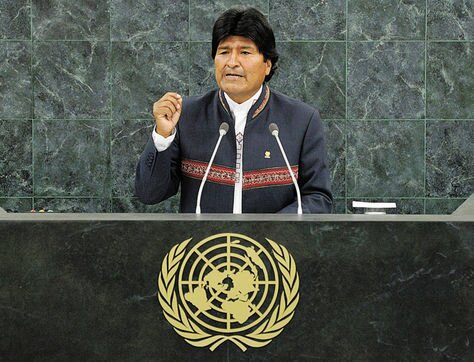
The current president of Bolivia is of Aymare origin – the first Amerindian to rise to the office of president. He too shows his heritage in his outfit – in a more moderate way. Here addressing the United Nations.
In theory, the borders of the former Spanish colonies would be determined based on the ‘uti possidetis juris’ principle, which implies that the borders are drawn based on the borders in colonial times. In the case of Bolivia reality proved more complex. Let’s take a closer look.
- The Bolivia-Peru-Brazil boundaries and the Republic of Acre. In northern Bolivia the run of the border will be decided between Peru, Bolivia and Brazil. Upon its independence in 1821 Peru extended much further east than modern Peru into what is now Brazil. After the dissolution of the Peru-Bolivia Confederation in 1839 this territory is transferred to Bolivia. Part of this territory was in 1839 occupied by Brazil. A border agreement is signed with Brazil in 1867 in which the occupied territory is ceded to Brazil along with a number of territories further south. In the Bolivian part – the Acre region – between 1899 and 1903, three attempts are made to set up an independent republic of Acre. The three republics were short lived due to Brazilian interventions – the majority of the population of the region being Brazilians that had migrated there for the rubber plantations. In 1903, the territory is divided by Brazil, Bolivia and Peru along the lines of the current borders.
- The Bolivia-Chile boundaries. Based on the ‘uti posseditis juris’ principle Bolivia, upon its independence, claimed the part of the Pacific coast that had belonged to the Viceroyalty of Rio de la Plata. De facto Chile – formerly part of the Viceroyalty of Peru – had by then moved its border up north occupying part of the territory claimed by Bolivia, claiming territory yet further to the north. A border agreement was signed in 1866. The border would eventually be established as an outcome of the War of the Pacific in which Chile in 1879 occupied the Antofagasta region. The 1884 truce put Chile in lasting possession of the Bolivian littoral, which was formally ceded to Chile in 1904. Bolivia has renewed its claim to the territory in recent years.
- The Bolivia-Argentina boundaries. Again, based on the ‘uti posseditis juris’ principle Bolivia claimed territories also claimed by Argentina: the Los Andes region in the west and part of the Chaco region in the east. The Los Andes region was in 1825 a possession of Bolivia, the Chaco region a possession of Argentina. The borders were settled through a 1889 treaty in which Bolivia ceded the Los Andes region and reneged its claims to the Argentinian Chaco region. The Los Andes region had lost its significance as a thoroughfare to the Bolivian littoral as Bolivia had lost the littoral in the War of the Pacific. The Bolivan claims to the Argentinian part of the Chaco region had become highly theoretical as after the War of the Tripple Alliance Argentina and Paraguay had established their borders with international recognition.
- The Bolivia-Paraguay boundaries. Bolivia finally invoked the ‘uti posseditis juris’ principle to claim a part of the Chaco region that was, in 1825, effectively a possession of Paraguay. The countries would be in negotiation over the border for well over a century. Treaties were signed at different times but none of these were to be ratified by both the Bolivian and the Paraguayan government. Finally, in 1932, the dispute would escalate into the Chaco War. As an outcome of the Chaco War the borders as we know them today were established in 1938. Note: the Chaco region is a region in South America covering large parts of Argentina, Bolivia and Paraguay – the conflicts focused on the central part of the region where the three countries meet.
Economy and demographics
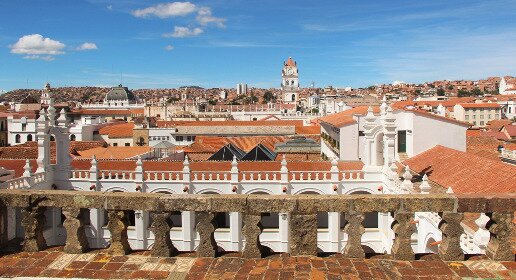
Sucre – so called since 1825 – was the capital of the Audiencia de Charcas in Spanish times and, until today, is the constitutional capital of Bolivia. The de facto capital is, since 1899, La Paz. Colonial style architecture abounds in Sucre.
Economically Bolivia has largely depended on its rich mineral resources. Since colonial times silver had been the most important resource – which it continued to be until the late 19th century. Tin subsequently became the mainstay of the Bolivian economy. Currently natural gas takes up the largest share of Bolivian exports. The economy was, until the 1950’s, dominated by a small oligarchy, that had also dominated politics. In the wake of the Bolivian National Revolution large parts of the economy were nationalized. From the 1980’s, reforms have liberalized the economy to become a market economy. Despite its natural resources Bolivia is one of the least developed countries in South America – on the United Nations Human Development Index only Guyana ranks lower.
The population consists of about 60% Amerindians – the largest groups still being the Quechuas and the Aymaras. Mestizos – people of mixed Amerindian and white origin – account for 30% of the population, 10% is white. All in all Bolivia is a country with country with a very diverse population. The official name of the country is ‘Plurinational State of Bolivia’, which seems justified when one knows that Bolivia counts 37 official languages.
Postal history Bolivia
The first stamps issued in Bolivia were issued as part of a concession granted by the government to a private company in 1863. This issue is disputed and referred to, but not listed, in the catalogs. The first government issue dates from 1867, a second from 1868. Both issues were printed from plates engraved by hand, each stamp on the plate being engraved separately. Thus many varieties exist – between 30 and 78 depending on the number of stamps on a plate for a specific denomination. Further varieties exist because the plates were retouched as they wore from printing. Also, in 1868, stamps printed by the American Bank Note Company in New York were issued. Bolivia has commissioned the printing of its stamps to a wide range of foreign printing houses. Bolivia joined the UPU in 1886. Until the present day Bolivia has issued stamps mainly with themes of national interest.
Between 1972 and 1995, the Michel catalog lists a significant number of souvenir sheets issued – almost 200. These sheets – that would seem to be aimed at the thematic collectors market – were issued by the postal authorities on behalf of the Bolivian Philatelic Federation to raise funds for philatelic exhibitions in Bolivia. The other catalogs do not list these sheets.
A British office operated in Cobija, a city in the Antofagasta region, from 1863 to 1878. Local issues appeared in 1911 in Santa Cruz and Villa Bella – overprints with a new face value. A regional postal tax issue appeared in 1946 in the province of Beni.
Album pages
← Previous page: BermudaNext page: Brazil →

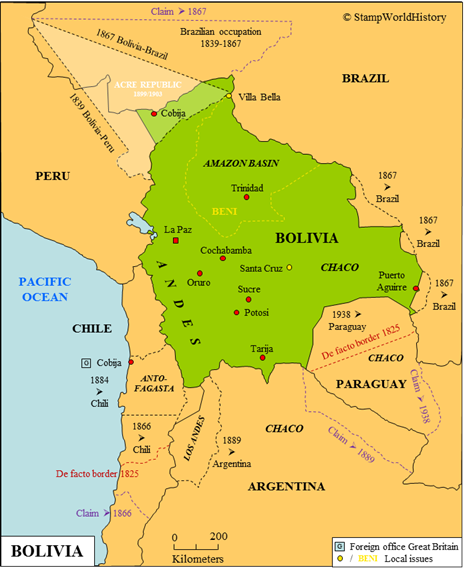
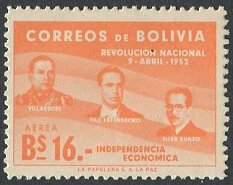






The following information (from Wikipedia) may be interesting for users of SWH.
The official name of Bolivia is Plurinational State of Bolivia. There are 37(!) officials languages in Bolivia. Gedi
Gedi
Thanks, good suggestion. Especially in combination with the number of official languages.
Gerben, I think it must be
Bolivia is a country with very diverse population. The official name ….
Gedi
Thanks for spotting the typo, Gedi.